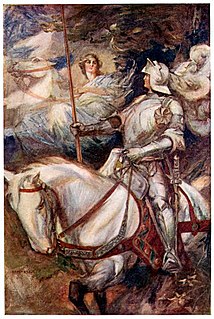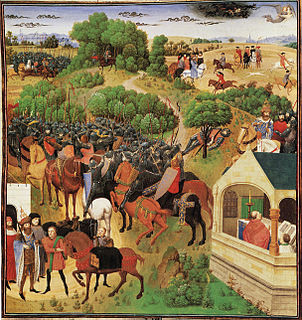 W
W"Bisclavret" is one of the twelve Lais of Marie de France written in the 12th century. Originally written in French, it tells the story of a werewolf who is trapped in lupine form by the treachery of his wife. The tale was popular and was reworked as The Lay of Melion, and is probably referenced in Sir Thomas Malory's Le Morte d'Arthur with the tale of Sir Marrok, who has a similar story.
 W
WA Breton lai, also known as a narrative lay or simply a lay, is a form of medieval French and English romance literature. Lais are short, rhymed tales of love and chivalry, often involving supernatural and fairy-world Celtic motifs. The word "lay" or "lai" is thought to be derived from the Old High German and/or Old Middle German leich, which means play, melody, or song, or as suggested by Jack Zipes in The Oxford Companion to Fairy Tales, the Irish word laid (song).
 W
WGraelent is an Old French Breton lai, named after its protagonist. It is one of the so-called anonymous lais and draws on Marie de France's Lanval.
 W
WMarie de France was a poet, possibly born in what is now France, who lived in England during the late 12th century. She lived and wrote at an unknown court, but she and her work were almost certainly known at the royal court of King Henry II of England. Virtually nothing is known of her life; both her given name and its geographical specification come from her manuscripts. However, one written description of her work and popularity from her own era still exists. She is considered by scholars to be the first woman known to write francophone verse.
 W
WMirour de l'Omme, which has the Latin title Speculum Meditantis, is an Anglo-Norman poem of 29,945 lines written in iambic octosyllables by John Gower. Gower's major theme is man's salvation. Internal evidence suggests that composition was completed before 1380. G. C. Macaulay discovered the only manuscript in the Cambridge University Library.
 W
WThe Mirror of Justices, also known in Anglo-Norman as Le mireur a justices and in Latin as Speculum Justitiariorum, is a law textbook of the early 14th century, written in Anglo-Norman French by Andrew Horn. The original manuscript is in the Parker Library, Corpus Christi College, Cambridge.
 W
WRoman de Rou is a verse chronicle by Wace in Norman covering the history of the Dukes of Normandy from the time of Rollo of Normandy to the battle of Tinchebray in 1106. It is a national epic of Normandy.
 W
WThe Song of Roland is an 11th-century epic poem based on the Battle of Roncevaux Pass in 778, during the reign of Charlemagne. It is the oldest surviving major work of French literature and exists in various manuscript versions, which testify to its enormous and enduring popularity in the 12th to 16th centuries.
 W
WThe Treatise is an Anglo-Norman poem written in the mid-13th century by Walter of Bibbesworth, addressed to Dionisie de Munchensi, with the aim of helping her to teach her children French, the language of the Norman aristocracy. It was a popular text in medieval England, and is a very early example of a book intended for reading to children.
 W
WWalter of Bibbesworth (1235–1270) was an English knight and Anglo-Norman poet. Documents confirm that he held land in the parish of Kimpton, Hertfordshire at the farm now called Bibbsworth Hall. About 1250 he served in Gascony under the seneschal Nicholas de Molis in the army of the English king Henry III. In 1270/1271 he is believed to have taken part in the Ninth Crusade on the evidence of a tençon or poetic argument between himself and Henry de Lacy, 3rd Earl of Lincoln. In the poem Walter, about to depart for Palestine, teases Henry for staying at home for the love of a certain woman. In fact the young Henry de Lacy, "recently married and with heavy responsibilities at home", did not take part in the Ninth Crusade. Walter went and returned. He was buried early in Edward I's reign at Little Dunmow in Essex.